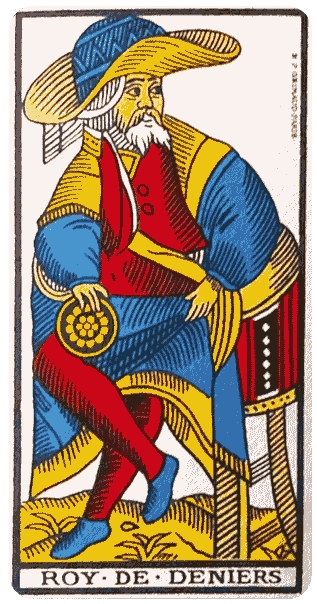synthetic meaning
Not wearing a crown, his head covered with an intricate hat resting on white hair, and in a rich and elaborate outfit, the King of Coins, sitting, with one leg crossed over the other, his body turned to the left and his head towards the right, symbolizes thereby mental richness and the human sciences [i.e., psychology and sociology, which used to be grouped under the rubric "sciences morales"], allowing by their judicious use and, from case to case, the gradual or immediate realization in matter of constructs engendered by the mind.
analytic meaning
The complexity of the hairstyle of the King of Coins indicates the ensemble of working plans which he embodies and which he reflects in the material world. The absence of a crown shows, in effect, that he does not radiate in the Universal the way the other kings do, but that he operates through the leans at the disposal of Man, in other words, through psychology which, by itself, cannot give communication with the Universal, that is to say, mastery through a higher plane.
specific analogies
The triangles on his hat represent constructions, because the triangle, through its immutable balance, is the essential schematic element of every edifice [1]. The blue colors of his cap, the flesh color of the higher section, and the yellow of the lower section indicate deduction and inductions, exercised over vital work, which allows matter to be directed and controlled. Its shape in an 8 indicates an undertaking in a closed circuit, thus complete and with the possibility of being realized.
The white hair below it is a rich supply of knowledge, in various currents and in the effluences from a higher plane; it denotes that in the King of Coins is powerful erudition, elaborate and luminous.
His white beard, an indication of will and the means of carrying it out, confirms an emission of synthetic currents, while his moustache, flesh colored, represents the contribution of nervous force.
The part of his blue cloak which his left hand is lifting implies, in as much as it is a coat, an envelopment by intuitive forces and, by his drawing it back, a willful condensation of auric fluids, a collection of psychic activities for a specific and precise action. That fold being made on his raised right leg accentuates a disposition towards action and makes it evident that it is soon.
The numbers 3, 2, and 7, marked by the three black points on his yellow collar, two buttons on his red vest, along with six white diamonds and a white line on the black back of his armchair, by their shapes, preside over the nature of the operations which the King of Coins effects on the three planes: mental, animistic, and material. On his collar, the three units, or points, indicate abstractions in a ternary mode, and, consequently, the application of mathematics to the triangular constructions of his hair. The two circles of his vest constitute a polarity, one which implies the reconciliation of opposites and presides over all combinations. The seven white figures (four squares and a line) traced on the black part of the chair, raised over four legs, shows by the seven the range of knowledges acquired in the material plane, represented by the double quaternary. The overall consideration of these three numbers affirms the materialization of the designs of the King of Coin, since the last number can be found inscribed outside of him. The six black dots on the flesh-colored crossbar of the chair define the small struggles which he encounters in the physical world; the four black lines connecting the base of the two visible legs of the chair represent the small points of resistance in his development, and the five black lines above are the small points of resistance in the transition that leads to the result.
The coin held in his right hand, therefore active, and placed on his raised knee, representing therefore the hinge of a levering arm ready to act, confirms an imminent setting-into-motion and an almost immediate realization. The coin is small because it represents a gathering of the human sciences, which is to say, an ensemble of means of construction more abstract than concrete, the smallness symbolizing the synthesis which, at his greatest, is reduced to a point.
On this Arcanum, the royalty of the figure is not indicated by the crown, this being absent, but by the richness and intricacy of his clothing, whose multiplicity of elements means an abundance of powers.
The King of Coins the only one who reposes on uneven ground. Because of this he stirs up matter through his mental and material activity. The tufts of grass which grow on the rough ground are flourishes of intelligence, and the white part of the soil represents the equipoise which he brings.
meanings as they relate to the three planes
MENTAL. Powerful, universal, insightful intelligence, the capacity for introspection in all domains.
ANIMISTIC. Not very lively, it is neutral in matters of affection. The materialization of hopes, support in the material world.
PHYSICAL. Diverse and very active affairs, changes in nature. Health, with the conflicts due to changes of temperament, for it is charged with fluid currents.
INVERTED. Great disorder, failure. Complete absence of scruples, imagination led towards evil.
In its Basic Meaning, the King of Coins represents the mastery of constructions in the material world through science and knowledge.
[1] We see it by noticing that the trusses and frames at the base of all constructions are an assemblage of triangles.
